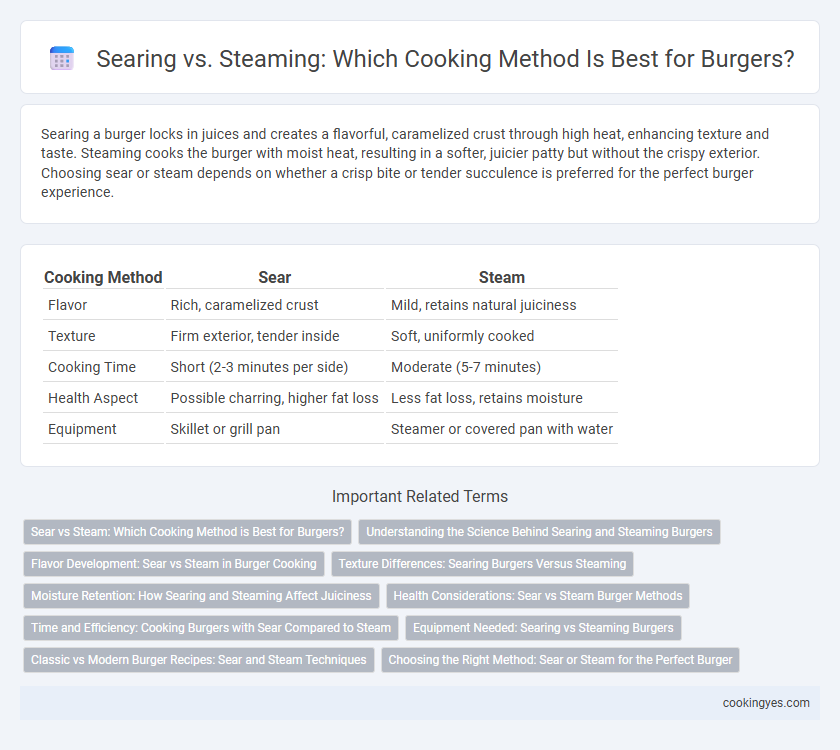Searing a burger locks in juices and creates a flavorful, caramelized crust through high heat, enhancing texture and taste. Steaming cooks the burger with moist heat, resulting in a softer, juicier patty but without the crispy exterior. Choosing sear or steam depends on whether a crisp bite or tender succulence is preferred for the perfect burger experience.
Table of Comparison
| Cooking Method | Sear | Steam |
|---|---|---|
| Flavor | Rich, caramelized crust | Mild, retains natural juiciness |
| Texture | Firm exterior, tender inside | Soft, uniformly cooked |
| Cooking Time | Short (2-3 minutes per side) | Moderate (5-7 minutes) |
| Health Aspect | Possible charring, higher fat loss | Less fat loss, retains moisture |
| Equipment | Skillet or grill pan | Steamer or covered pan with water |
Sear vs Steam: Which Cooking Method is Best for Burgers?
Searing burgers creates a flavorful crust through Maillard reaction, enhancing taste and texture with a caramelized exterior. Steaming burgers, by contrast, locks in moisture and produces a tender, juicier patty without the crispy edges. For the best burger experience, searing is preferred for its depth of flavor and appealing texture, while steaming suits those prioritizing a moist and soft interior.
Understanding the Science Behind Searing and Steaming Burgers
Searing burgers involves cooking at high temperatures to create the Maillard reaction, which forms a flavorful, caramelized crust by browning amino acids and sugars. Steaming uses moist heat to cook burgers evenly and retain juiciness by preventing moisture loss, but it lacks the intense browning and flavor development of searing. Understanding that searing enhances flavor through chemical reactions while steaming preserves moisture guides cooks in choosing methods based on desired texture and taste profiles.
Flavor Development: Sear vs Steam in Burger Cooking
Searing a burger enhances flavor development through the Maillard reaction, creating a rich, caramelized crust that intensifies the meat's savory taste. Steaming functions by cooking the burger gently with moist heat, which preserves juiciness but does not contribute to browning or complex flavor compounds. Therefore, searing is preferred for maximizing depth of flavor, while steaming maintains moisture with a milder taste profile.
Texture Differences: Searing Burgers Versus Steaming
Searing burgers creates a Maillard reaction that produces a crispy, caramelized crust, enhancing flavor and texture with a satisfying bite. Steaming, by contrast, retains moisture and results in a softer, juicier burger but lacks the browned crispiness that searing provides. Texture differences between seared and steamed burgers hinge on crust development versus moisture preservation, directly impacting the eating experience.
Moisture Retention: How Searing and Steaming Affect Juiciness
Searing burgers creates a flavorful crust that seals in natural juices, enhancing moisture retention and delivering a succulent bite. Steaming cooks burgers with gentle vapor heat, preserving internal moisture but lacking the caramelized texture that searing provides. Combining both methods can maximize juiciness by locking in moisture while adding a rich, seared exterior.
Health Considerations: Sear vs Steam Burger Methods
Searing burgers creates a flavorful crust by cooking at high temperatures, which can lead to the formation of potentially harmful compounds like heterocyclic amines (HCAs). Steaming burgers, on the other hand, cooks the meat gently without direct high heat, reducing the risk of these carcinogens and preserving more nutrients. Choosing steaming over searing can support healthier eating by minimizing exposure to compounds linked to cancer while maintaining moisture and tenderness.
Time and Efficiency: Cooking Burgers with Sear Compared to Steam
Searing burgers cooks them quickly by applying high heat directly, creating a flavorful crust in just a few minutes per side. Steaming takes longer, relying on moist heat to cook the burger evenly, which may result in a less intense flavor and a softer texture. For faster cooking and enhanced taste, searing is more efficient and time-effective than steaming.
Equipment Needed: Searing vs Steaming Burgers
Searing burgers requires a heavy-duty cast iron skillet or a flat-top griddle capable of reaching high temperatures to create a caramelized crust, enhancing flavor and texture. Steaming burgers necessitates a steamer basket or a specialized steam oven that gently cooks through moist heat, preserving juiciness and tenderness without browning. Each method's required equipment directly influences the burger's final taste, texture, and cooking efficiency in professional kitchens or home setups.
Classic vs Modern Burger Recipes: Sear and Steam Techniques
Searing burgers creates a flavorful crust through high-heat caramelization, ideal for classic recipes emphasizing rich, smoky taste and texture. Steaming, often used in modern techniques like the "steamed burger," produces a juicier, softer patty by trapping moisture during cooking. Combining sear and steam methods balances a crisp exterior with a tender interior, enhancing both traditional and contemporary burger experiences.
Choosing the Right Method: Sear or Steam for the Perfect Burger
Searing a burger creates a flavorful crust through the Maillard reaction, locking in juices and enhancing texture with caramelized edges. Steaming ensures even cooking and a tender, moist patty by using steam heat to prevent drying out, ideal for leaner meats. Selecting sear or steam depends on desired taste and texture: sear for a crispy, bold flavor, steam for soft, juicy consistency without charring.
Sear vs Steam for Cooking Method Infographic

 cookingyes.com
cookingyes.com